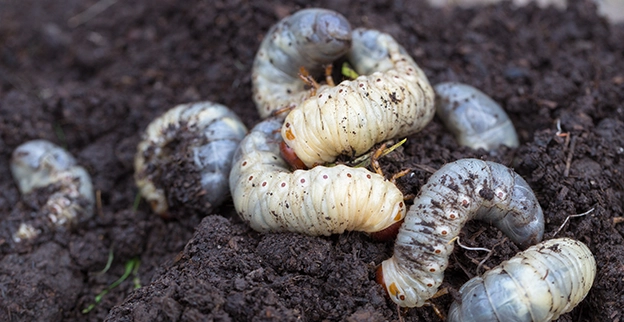Beetles lay their eggs in lawns, where the larvae hatch and begin feeding on grass roots. This leads to unsightly brown patches and dead grass, frustrating even the most diligent homeowners. An underground pest problem like this can wreak havoc on your yard if left untreated. The most effective way to tackle grub infestations is by partnering with experienced lawn care experts. Lawn Pride of Rockwall-Wylie provides specialized grub control programs designed to stop grubs from damaging your lawn. Discover how our services can protect your grass. Contact us for grub control services in Rockwall, Wylie, Allen, Rowlett, Murphy, Parker, Lucas, Lavon, Nevada, Inspiration, Maxwell Creek, Murphy Farms, The Shores, Bozeman Farms, Elavon, Hillsdale, and Stone, TX.
Telltale Indicators of a Grub Infestation
Most homeowners are unaware they have a grub issue lurking beneath their lawns. Identifying the problem is the first step to resolving it. Since grubs spend most of their time underground, their damage often appears as patches of unhealthy or dying grass. There are a few indicators that point to a grub infestation. If you spot any of the following warning signs, it’s time to consider professional lawn grub control to prevent further damage. Below are some of the most common signs that grubs are present:

Beetles
Grubs are the immature stage of various beetles, including June bugs, masked chafer beetles, and Japanese beetles. Certain species, like the Japanese beetle, are invasive and lack natural predators to regulate their numbers. These beetles typically emerge from the soil between May and July, becoming more noticeable during this time. However, the timing can shift based on regional factors and weather patterns.
Dead Grass
Grub damage in your lawn often shows up in different ways, with dead grass being the most frequent issue. Grubs feed on roots and other organic matter below the surface. This disrupts the flow of nutrients and water to your grass, ultimately leading to its death.
Rolling Dead Grass
The best method for locating grubs is simple. If you think part of your lawn might be affected, try pulling up that area of grass. In cases of severe grub damage, the grass will lift easily, much like peeling back a carpet. As you do this, you’ll probably notice a few grubs visible in the soil beneath.
Preventative Treatments Compared to Curative Treatments
Grub control typically falls into two categories: preventative and curative. Preventative treatments target grubs in their early stages, stopping them before they hatch or become active enough to harm your lawn. Curative treatments, however, are designed to tackle existing infestations, eliminating grubs that have matured and are actively feeding on your grass. For most homeowners dealing with grub issues, the best approach is a program that integrates both methods at different points throughout the year to align with the grubs' lifecycle.
Our Special Offers
We understand your goal to keep your lawn looking its best. We take pride in your lawn because we know you do, too. Check out our special offers to see how you can save on your next lawn care application.
Services We Provide
Customer Reviews
View All Reviews
The Neighborly Done Right Promise® delivered by LawnPride®, a proud Neighborly company.
Lawn Pride of Rockwall Wylie
Our specialists deliver the level of lawn care you need and deserve. We're preferred providers of Rockwall Wylie lawn care, distinguished by our commitment to ensuring our customers understand our processes and are thrilled with the results. You can count on Lawn Pride to provide exceptional customer care as we develop a lawn that makes you proud. Lawn Pride of Rockwall Wylie provides lawn care services for the following cities:
Our Customers’ Frequent Grub Control Questions
Grub control can be a bit tricky to figure out unless you’re a seasoned expert in lawn care. While our team is always ready and willing to help with questions or to check your yard for grubs, Lawn Pride of Rockwall-Wylie has put together answers to some of the most frequently asked questions about grubs:

Join Our Team
“We have the power to make things better.” That’s our mantra, not only for our customers' lawn issues, but also you, a future team member! At LawnPride, we provide a career path for growth and treat you like family. They know that a happy, motivated team is key to serving customers well. That's why we value integrity and respect and create a strong work ethic.
